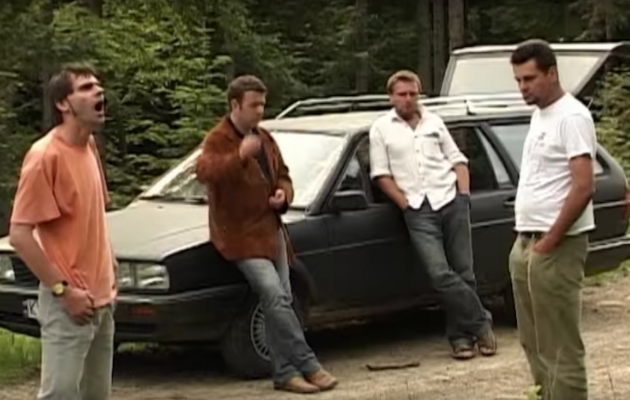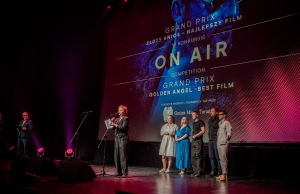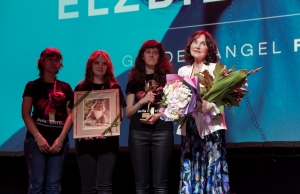Polish Independent Film Classics at Tofifest 2016

We would like to present the first ever Polish film festival with a section dedicated to bringing back the great grass-roots revolution that swept through Polish cinemas, in the years 1998-2007. It was the Revolution of Independent Films.
Indeed, the independent film genre (in Poland referred to as “off” cinema) produced some of the most interesting and intellectually most original films, during the afore-mentioned decade. The weapon of that revolution was a VHS camera and the first small digital camera that came to life. It was a time, when people “from nowhere” started making films, and they often had virtually no connection with the film industry. And they soon won the hearts of audiences.
They were such film productions as Krew z nosa by Dominik Matwiejczyk, Homo Father by Piotr Matwiejczyk, I co wy na to, Gałuszko? by the duo of Marcin Sauter and Maciej Cuske – cinemas were full and films started collecting awards during festivals.
By introducing this section, we return to our own roots. You need to remember that the first Tofifest festival (which was back then called Toffi) was in fact dedicated to independent films. It was a small-scale review of independent films, which was a continuation of the concept started in Dom Muz (a centre for culture). And we have grown a little throughout those 14 years, as you might have noticed...
But let us go back to the end of the twentieth century and the beginning of the twenty-first century, when the Polish film industry had its great break-through.
A time of crises and a time of triumph
The end of the twentieth century and the beginning of the twenty-first century was not a particularly good time for Polish cinema. The film industry had virtually no money. Back then, it was a usual practice to complain about mainstream films. Polish films were permanently underfunded, which had its toll on the work quality of even the best of film directors. And we need to remember that the Polish Film Institute came to existence, as late as in 2005.
The Polish Film Festival that took place in Gdynia accepted all films made in a given year, because their total number would never exceed 15 or 20 productions. It was the time when such oddities as “Gulczas, a jak myślisz...”, directed by Jerzy Gruza or “Polish Kitsch Project”, directed by Mariusz Pujszo, were made – today, they would be treated as a funny joke, at best. Unfortunately, back then they were widely commented in the mainstream media.
No wonder that audiences turned their back on Polish cinema. As a result, only a little less than a million people went to see Polish films in cinemas, in 2005 (as against 8.3 million people that watched Polish films in 2015 – “Listy do M. 2” alone attracted as many as 2.8 million viewers).
Facing a complete disaster, film-makers rushed to film adaptations of books from a reading list, in order to attract audiences. However, that did not help much, since such big productions as “Ogniem i mieczem”, directed by Jerzy Hoffman (1999) and “Quo Vadis” directed by Jerzy Kawalerowicz (2001) were spectacular failures. Unfortunately, the successes of such films as “Revenge” by Andrzej Wajda or a winner of the Palme d’Or Award, “The Pianist”, directed by Roman Polanskidid not change that situation much.
And then, something broke out in our film industry.
The big BOOM!
Independent films came up and we had a true revolution. At the very dawn of the genre, its initiators had absolutely no clue how big it would later grow to be. Fortunately, they quickly understood it, when the country was flooded with festivals of independent films aimed at presenting the very best (well, sometimes the very worst too) of the films made by independent film-makers.
Many film festivals were born instantaneously, such as Off-Cinema in Poznan, Oskariada in Warsaw, KAN in Wroclaw, Krakffa in Krakow, Zoom-Zbliżenia in Jelenia Gora, and Happy End in Rzeszow. And there were many, many more. They are responsible for the truly frenzy reaction to the Polish “indie” films. One of such festivals was the Torun-based “Off” festival, which was then transformed into an independent festival under the name Tofifest – before that, it was simply called “Toffi”.
“Bułgarski pościkk” and karate chops
Though there is still no research done about independent films, it is generally agreed that the first film work categorised as independent was the short films produced by Zespół Filmowy Skurcz – such as, for example, “Bułgarski pościkk” that was a pastiche of the Asian martial art films. The first independent film that was selected for the film festival in Gdynia and screened in cinemas was “Kallafiorr” by Jacek Borcuch (he later made “Tulips” i “All That I Love”).
According to the nice words published on www.filmpolski.pl, which are further backed by Wikipedia, what followed was a dramatic increase in the number of “low-budget independent films”. Dominik and Piotr Matwiejczyk, Bodo Kox, Jaroslaw Sztandera, Filip Marczewski, Dariusz Nojman, Mathias Mezler, or DDN Groups – back then, they were pretty “hot” names.
Tofifest is very happy to have a solid Torun touch in the genre of independent films, which is a full-feature comedy about Knights of the Teutonic Order entitled “1409 – afera na zamku Bartenstein”, made by Kompania M3. The film was in production from 1998 to 2001, and had its première in 2005, starring Jan Machulski, Borys Szyc, Joanna Brodzik, and Marcin Dorocinski.
Polish independent films are back!
The section dedicated to Polish independent cinema will include, among others, “Krew z nosa” by Dominik Matwiejczyk (2003). It was a full-length film and a great success, which was highly valued by film critics, including “mainstream” ones, as well. The story about a boy living in a big housing estate, who decides to become a hip hop musician, in order to change his life - it was the very first leading role of Bodo Kox. “The director demonstrated a scathing perspective on modern young people and their culture, deprived of any moralising,” wrote film critics. The film won numerous film festivals, including Tofifest 2005.
The independent film genre was able to discuss issues that the mainstream cinema of the time was not capable of commenting. For example, “Homo Father” by Piotr Matwiejczyk (2005) was one of the first Polish films that openly discussed the problem of child adoption by homosexual couples. The film was even selected for the independent competition during the 30th edition of the Gdynia Film Festival, although the “controversial” 16-minute sequence was cut out from it. The film screened at Tofifest will be its full version.
Independent film-makers were not always immersed in serious topics and they did have a sense of humour. To prove that, the section dedicated to independent films includes two unique comedies. “I co wy na to, Gałuszko?” (1998/2001) was made by two Bydgoszcz natives, Marcin Sauter and Maciej Cuske, who have already become recognised film directors. According to a legend, the film was made using snippets of already recorded films – it was a dark comedy about a certain loser, who has a “Syrena” car that... wreaks havoc among residents of a small town in Kashubia.
And there was also a mad comedy entitled “Marco P. i złodzieje rowerów” by Bodo Kox (2005) that won between ten and twendy Grand Prix awards. It is a story about the title Marco, a cycling buff, who exacts a merciless revenge on the thieves who stole his bike.
We are not going to go into detail about all the films included in this section – feel free to take a look at the programme.
Do you love Polish cinema? The Polish Independent Film Classics is a must for you
We believe that every enthusiast of Polish cinema that has a sense of self-respect should definitely know the films included in the section. It is so, because they are the very roots of the great transformation that made Polish films of today receive Academy Awards, Golden Bears, and Golden Lions.
And that decade at the turn of the 20th century was the reign of true and beautiful faith in the meaning of cinema, and a pure declaration of love for that art. We shall return to those emotions during Tofifest 2016.
Also in this section
- Idea
- Sections
- Awards
- Jury of 2025 On Air Competion
- Archive




